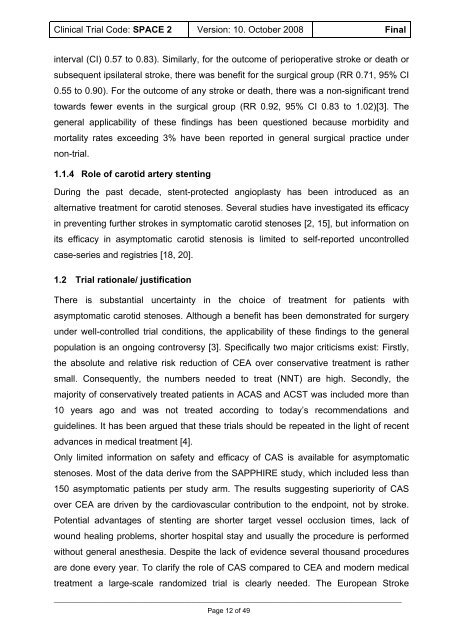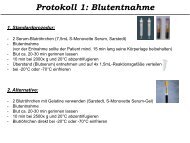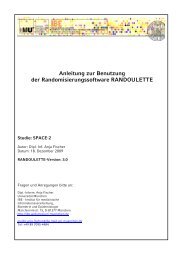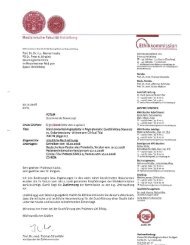CLINICAL TRIAL PROTOCOL SPACE 2 Stent ... - SPACE-2 Studie
CLINICAL TRIAL PROTOCOL SPACE 2 Stent ... - SPACE-2 Studie
CLINICAL TRIAL PROTOCOL SPACE 2 Stent ... - SPACE-2 Studie
Create successful ePaper yourself
Turn your PDF publications into a flip-book with our unique Google optimized e-Paper software.
Clinical Trial Code: <strong>SPACE</strong> 2 Version: 10. October 2008 Final<br />
interval (CI) 0.57 to 0.83). Similarly, for the outcome of perioperative stroke or death or<br />
subsequent ipsilateral stroke, there was benefit for the surgical group (RR 0.71, 95% CI<br />
0.55 to 0.90). For the outcome of any stroke or death, there was a non-significant trend<br />
towards fewer events in the surgical group (RR 0.92, 95% CI 0.83 to 1.02)[3]. The<br />
general applicability of these findings has been questioned because morbidity and<br />
mortality rates exceeding 3% have been reported in general surgical practice under<br />
non-trial.<br />
1.1.4 Role of carotid artery stenting<br />
During the past decade, stent-protected angioplasty has been introduced as an<br />
alternative treatment for carotid stenoses. Several studies have investigated its efficacy<br />
in preventing further strokes in symptomatic carotid stenoses [2, 15], but information on<br />
its efficacy in asymptomatic carotid stenosis is limited to self-reported uncontrolled<br />
case-series and registries [18, 20].<br />
1.2 Trial rationale/ justification<br />
There is substantial uncertainty in the choice of treatment for patients with<br />
asymptomatic carotid stenoses. Although a benefit has been demonstrated for surgery<br />
under well-controlled trial conditions, the applicability of these findings to the general<br />
population is an ongoing controversy [3]. Specifically two major criticisms exist: Firstly,<br />
the absolute and relative risk reduction of CEA over conservative treatment is rather<br />
small. Consequently, the numbers needed to treat (NNT) are high. Secondly, the<br />
majority of conservatively treated patients in ACAS and ACST was included more than<br />
10 years ago and was not treated according to today’s recommendations and<br />
guidelines. It has been argued that these trials should be repeated in the light of recent<br />
advances in medical treatment [4].<br />
Only limited information on safety and efficacy of CAS is available for asymptomatic<br />
stenoses. Most of the data derive from the SAPPHIRE study, which included less than<br />
150 asymptomatic patients per study arm. The results suggesting superiority of CAS<br />
over CEA are driven by the cardiovascular contribution to the endpoint, not by stroke.<br />
Potential advantages of stenting are shorter target vessel occlusion times, lack of<br />
wound healing problems, shorter hospital stay and usually the procedure is performed<br />
without general anesthesia. Despite the lack of evidence several thousand procedures<br />
are done every year. To clarify the role of CAS compared to CEA and modern medical<br />
treatment a large-scale randomized trial is clearly needed. The European Stroke<br />
_______________________________________________________________________________________________________<br />
Page 12 of 49





